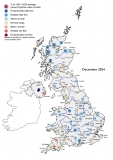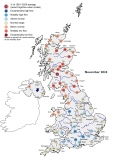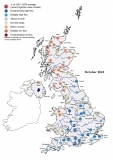Submitted by Eugene Magee on
January was a sunny and exceptionally dry month, the seventh driest January for England & Wales in a series from 1910. The UK recorded half of the 1991-2020 average rainfall, and substantial parts of south-east England received less than a third of average; it was the second driest January in Anglian region. The month began with the warmest New Year’s Day on record and January was particularly mild in the Scottish Highlands, the 2nd highest January mean temperature in a series from 1910. After drier than average weather over the last three months (particularly in the south), soil moisture was generally slightly below field capacity and deficits persisted in eastern England centred on The Wash. River flows were below normal across most of the UK, between half and two thirds of their average, and notably low in some catchments draining the Scottish Borders. Groundwater levels remained predominantly within the normal range, with the exception of notably low levels in the Carboniferous Limestone of south Wales. Reservoir stocks were broadly as expected for the time of year, marginally below average at the national scale though with some more notable shortfalls at reservoirs in northern England (e.g. Northern Command Zone, Kielder). Despite the predominance of dry weather over the November-January timeframe, reservoir stocks and groundwater levels are relatively healthy, and plentiful rainfall over the first half of February has also helped to strengthen the water resources situation towards the onset of spring.



